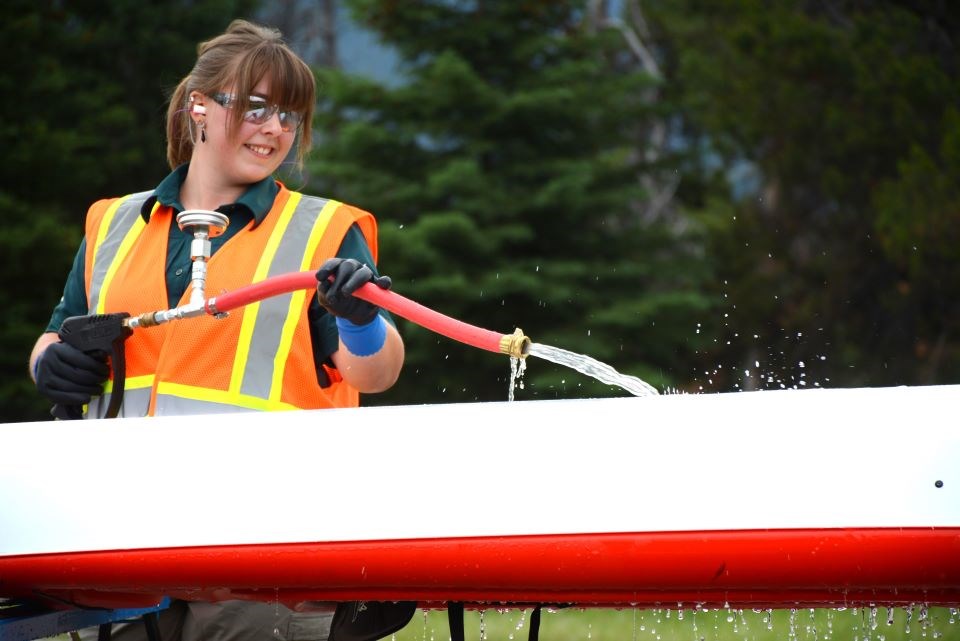Parks Canada’s aquatic invasive species (AIS) prevention program will bring in additional measures to better protect the waters of Jasper National Park.
Since visibility is key, the first and second orders of business involve the locations of the inspection station services stations and the size of the roving public education team, says Christopher Waldinsperger, AIS prevention program co-ordinator.
“We're going to have a main inspection station located on the Maligne Lake Road, and then we're going to have an additional station located at Whistlers Campground,” Waldinsperger said.
“We're going to have an increased presence at our water bodies throughout the park, educating and talking with visitors about the importance of AIS prevention and the ‘clean, drain, dry’ proactive steps.”
The AIS prevention program operated seven days a week from late June through the Thanksgiving weekend during the 2023 pilot.
Team members patrolled high-traffic waterbodies including Maligne, Talbot, Patricia, Pyramid, Edith and Annette Lakes while also conducting monitoring activities such as shoreline surveys and substrate sampling as a way to understand and address the potential threats to our aquatic ecosystems.
The team members engaged with more than 3,000 visitors across the park last year.
Visitation to the sole inspection station services station at Cottonwood Creek Road wasn’t as high as they would have hoped for. Still, the experience offered them a lot of valuable insight.
While much was learned from their efforts in 2023, the goal is to have an even greater number of interactions with the public. For that, the Maligne Lake Road is seen as the key gateway.
“We're going to put more resources towards that roadway, and hoping to meet people on the Maligne Lake Road will be of greater convenience to them and allow us to inspect more boats as they head down that way,” Waldinsperger said.
The station set for Whistlers Campground will have its sights set on high-risk watercraft coming from outside of the park from different locations. The AIS team will be there as visitors enter the campground with the decontamination station ready to deal with watercraft on sight and all free of charge. The team will also be available to answer all questions.
Vigilance is required as there will never be a day when this program’s team members can say that the Park’s waterbodies are safe for once and all.
“The threat is there,” Waldinsperger said.
Parks Canada recently closed all bodies of water in British Columbia's Kootenay and Yoho national parks and restricted watercraft in Waterton Lakes National Park to slow the spread of invasive species.
Whirling Disease was discovered in Banff National Park several years ago and it has also spread to Yoho and Kootenay National Parks in British Columbia.
“You can see how the spread keeps on getting closer to home,” Waldinsperger said.
He reinforced the message of “clean, drain, dry” while adding that those who recreate on waterbodies outside of the province should do their own research on what potential risks might lie therein.
Watercraft should be dry for at least 48 hours (or at least 30 days after use in the United States or provinces other than British Columbia, Alberta and the territories).
“It will help keep Jasper National Park free of invasive species, hopefully, for now and long into the future,” Waldinsperger said.
Aquatic invasive species such as Zebra mussels, whirling disease, Northern crayfish and Eurasian milfoil bring with them the potential to destroy native animal and plant species, completely altering the ecosystem and the food chain, carrying those effects down from the headwaters Athabasca. On top of that, they would change the look and feel of the beaches, especially as Zebra mussels have razor sharp shells.
In short, nothing would be safe and nothing would be the same afterward.
“It's wide ranging from both ecological impacts to the recreational impacts as well,” Waldinsperger said.
Lakes and water bodies in Jasper National Park will remain open for recreational activities involving non-motorized watercraft.
Watercraft with gas motors will not be permitted, and those with electric motors will be allowed on Maligne, Medicine, Talbot, Pyramid and Patricia Lakes.



